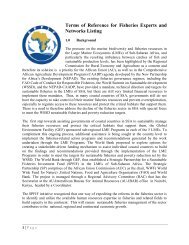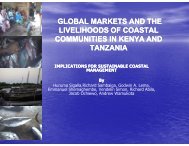Managing Marine Protected Areas Managing Marine Protected Areas
Managing Marine Protected Areas Managing Marine Protected Areas
Managing Marine Protected Areas Managing Marine Protected Areas
Create successful ePaper yourself
Turn your PDF publications into a flip-book with our unique Google optimized e-Paper software.
S.Wells<br />
It is also important to ensure that all aspects of<br />
recruitment are carried out as fairly, efficiently and<br />
transparently as possible. Following appointment, a<br />
probationary period (usually 3-6 months) may be<br />
appropriate to see if the new employee performs well. The<br />
new staff member should be given the necessary training<br />
or induction course and helped to settle in.<br />
DAY-TO-DAY STAFF PERFORMANCE<br />
All staff must have clearly assigned roles and responsibilities,<br />
laid out in their Terms of Reference and individual<br />
work plans. These should relate clearly to the job<br />
description, and set realistic and time bound targets or<br />
measurable standards that must be accepted by both<br />
employer and employee. ‘Output’ rather than ‘input’<br />
related work standards should be set, e.g. ‘MPA vehicles<br />
must not break down as a result of lack of engine oil’,<br />
rather than ‘check the engine oil once a week’; ‘the beach<br />
by the guest houses must be clean’ rather than ’clean the<br />
beach every morning’.<br />
Staff often prefer to wear uniforms rather than their own<br />
clothes, as it saves on wear and tear, and provides them<br />
with the necessary status when dealing with visitors,<br />
stakeholders and particularly those who may be causing<br />
problems for the MPA.<br />
PERFORMANCE APPRAISALS<br />
An annual performance appraisal for each staff member is<br />
increasingly common in many organisations. It is used to<br />
set and review performance objectives and to determine<br />
training and development needs, and it can be a valuable<br />
tool for maintaining motivation. Other ways to motivate<br />
staff are to hold regular staff meetings to discuss progress<br />
and concerns, and to organise social events (preferably<br />
outside work hours!).<br />
STAFF TRAINING<br />
Periodically it will be necessary to carry out an<br />
assessment of capacity and skills among the staff and<br />
organise training where particular skills are lacking.<br />
Training can take many forms, from formal courses,<br />
exchange visits and study tours, to on-the-job training<br />
which might involve participation in workshops and<br />
meetings, and increasing responsibility. WIOMSA’s<br />
training course for MPA managers which takes place every<br />
two years is one useful option for increasing staff skills.<br />
KEY POINTS FOR THE MPA<br />
❑ Make sure all staff have clear and well understood<br />
job descriptions, a line manager, clearly defined<br />
annual work plans and that progress is assessed on<br />
a regular basis.<br />
❑ Hold regular staff meetings, preferably at least one<br />
a week.<br />
❑ Ensure that performance appraisals are carried out<br />
on a regular basis, and in a participatory manner.<br />
❑ Conduct a capacity building needs assessment<br />
before launching into training.<br />
❑ The manager should regularly evaluate how best to<br />
deploy staff and make sure that they are willing<br />
and able (through training) to be flexible, given<br />
that management priorities may change over time.<br />
❑ Become familiar with local labour law, statutory<br />
minimum pay and conditions of employment,<br />
disciplinary and dismissal procedures.<br />
❑ If staff are not ‘government employees’ have a<br />
local labour lawyer draw up a standard<br />
employment contract.<br />
❑ Remember the key to good staff management is<br />
ensuring staff work together as a team.<br />
Sources of further information<br />
Bird, P. 1998. Performance Appraisals. Hodder and Stoughton Ltd.,<br />
London UK.<br />
Corfield, T. 1993. The Wilderness Guardian: A Practical Handbook.<br />
African Wildlife Foundation/The David Sheldrick Wildlife Trust.<br />
Longman, Kenya. 701pp.<br />
Greenwood, D. 1996. Taking on staff: how to recruit the right<br />
people for the right job. Business Basics Series, How to Books,<br />
Plymouth, UK.<br />
Humphrey, S. 2003. Administration and Management. Module 6.<br />
In: Francis, J. et al. (eds.). Training for the Sustainable Management<br />
of <strong>Marine</strong> <strong>Protected</strong> <strong>Areas</strong>: a Training Manual for MPA Managers.<br />
CZMC/WIOMSA.<br />
SEACAM. 1990. From a good idea to a successful project: a manual<br />
for development and management of local level projects. SEACAM,<br />
Maputo. 152pp.<br />
Taylor, G. 1996. <strong>Managing</strong> Recruitment and Selection. Directory of<br />
Social Change, London, UK.<br />
http://www.toolkit.cch.com/text/p05-0000.asp – gives practical<br />
details on recruitment and staff motivation.<br />
http://www.ee.ed.ac.uk/~gerard/Management/index.html –<br />
information on basic management skills.<br />
http://www.jimcollins.com/ - good articles on management.<br />
http://economist.com/surveys/PrinterFriendly.cfm?Story_ID=77<br />
0819 – good articles on management.<br />
http://www.wiomsa.org – or secretary@wiomsa.org – for<br />
information on the WIOMSA training courses for MPA personnel.<br />
Visitor engaging with staff in Curieuse<br />
<strong>Marine</strong> Park, Seychelles.<br />
Sheet D1 <strong>Managing</strong> <strong>Marine</strong> <strong>Protected</strong> <strong>Areas</strong>: A TOOLKIT for the Western Indian Ocean






